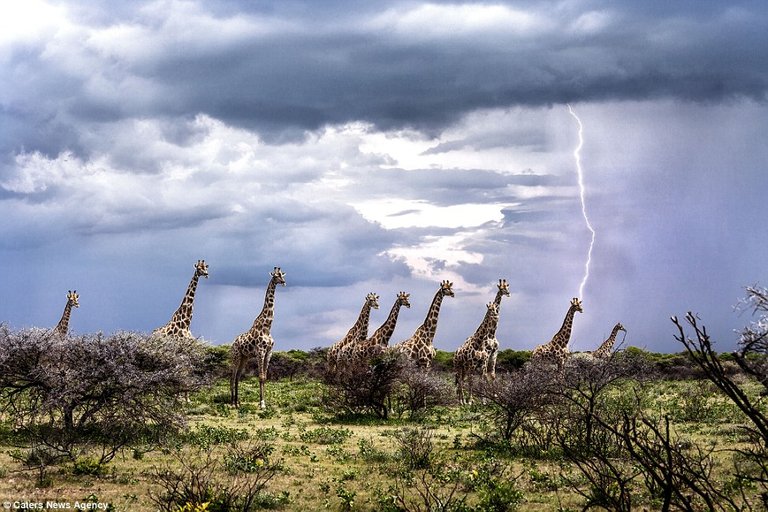
Two months ago, Reddit user infernograve woke from a vivid dream. As wakefulness crept back, the dream did not recede, rather, it stuck in his mind, piquing his curiosity and prompting a burning question. He subsequently logged into Reddit's popular AskScience subreddit to share it:
"Do giraffes get struck by lightning more often than other animals?"
The question is now the most popular ever asked on the forum.
So do giraffes get struck by lightning at higher rates? Intuitively, the obvious answer is "yes." Standing between fourteen and nineteen feet tall when fully grown, giraffes tower above the savannah and open woodland landscapes where they dwell. Of course, lightning doesn't always strike the tallest object in an area, but taller objects are more susceptible due to the shorter gap between the object and the lightning's point of origin.
As zoologist Darren Naish learned when researching for a potential book, "Between 1996 and 1999, the Rhino and Lion Reserve near Krugersdorp, South Africa, had two of its three giraffes killed by lightning – the third animal (a juvenile) was also struck but survived."
There was also an incident in 2003 in which lightning struck and killed Betsy the giraffe at Disney's Animal Kingdom in Florida. At the time, it was the only fatality of the sort to ever occur in the park.
Anecdotes aside, there aren't really any concrete numbers on the subject. There is at least one pertinent published paper, however.
In 2011, Universiti Putra Malaysia electrical engineer Chandima Gomes, one of the foremost experts on lightning safety, wrote what has become the definitive scientific treatise on animal lightning strikes. He noted that "animals with a large separation between their front and back feet... are vulnerable to receive lightning injuries due to the dangerous potential differences that may built up between these feet, in the event of nearby lightning." For animals like giraffes, this means that dangerous current could travel through their vital organs. Gomes also wrote that taller animals like elephants and giraffes could be victims of side flashes, in which lightning rebounds after striking a nearby tree to hit the head of the animal. They might also suffer from "touch potential" if in direct contact with a struck tree, where potentially deadly current passes from the branches to the animal.
Gomes' explanations have solid scientific grounding, but again, without clear-cut numbers, it's hard to know for sure if these scenarios equate to giraffes being struck at higher rates than other animals. Giraffes' risk of lightning strike could very well be higher, but because lightning strikes are so rare, that elevated risk would not translate to an epidemic of violent, electrifying death.
Very good and votes your last three articles very good right now the compares I hope for you thanks
Hi! I am a robot. I just upvoted you! I found similar content that readers might be interested in:
http://www.realclearscience.com/blog/2017/06/23/do_giraffes_get_struck_by_lightning_more_than_other_animals.html
copy/pasted article?
It's funny this question, I'll follow you because I love this kind of article and your blog is cool.